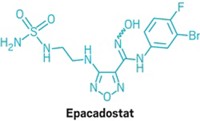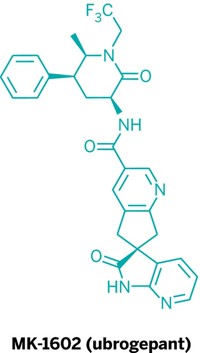Advertisement
Grab your lab coat. Let's get started
Welcome!
Welcome!
Create an account below to get 6 C&EN articles per month, receive newsletters and more - all free.
It seems this is your first time logging in online. Please enter the following information to continue.
As an ACS member you automatically get access to this site. All we need is few more details to create your reading experience.
Not you? Sign in with a different account.
Not you? Sign in with a different account.
ERROR 1
ERROR 1
ERROR 2
ERROR 2
ERROR 2
ERROR 2
ERROR 2
Password and Confirm password must match.
If you have an ACS member number, please enter it here so we can link this account to your membership. (optional)
ERROR 2
ACS values your privacy. By submitting your information, you are gaining access to C&EN and subscribing to our weekly newsletter. We use the information you provide to make your reading experience better, and we will never sell your data to third party members.
Pharmaceuticals
The New Merck
The recently merged pharmaceutical company unveils its pipeline at R&D day
by Lisa M. Jarvis
May 24, 2010
| A version of this story appeared in
Volume 88, Issue 21

Top executives of Merck & Co. stood earlier this month before a crowd of analysts and investors bussed to Whitehouse Station, N.J., and unveiled a drug pipeline freshly pruned after last year’s acquisition of Schering-Plough. They walked through scientific background and development plans for the most advanced candidates, putting particular emphasis on the full cardiovascular pipeline created by the merger.
The stakes are high. As Merck’s chief executive officer, Richard T. Clark, pointed out in a Q&A with press after the R&D day, the company has only completed one other deal of this size in its history. To say investors are scrutinizing the scientific integration process is an understatement.
After the acquisition, managers embarked on a comprehensive review of projects from both companies. They ended up with 22 compounds and vaccines in Phase II clinical trials and 20 in Phase III. Roughly 55% of the projects are legacy Merck, and 45% are legacy Schering-Plough.
“Merck’s pipeline certainly has a different feel than it did back in 2005/2006, which was a more productive time for the company,” Bernstein Research analyst Tim Anderson wrote in a note to investors after the event. “But this is not unique, and overall we continue to believe that Merck remains one of the better R&D companies.”
The two most anticipated late-stage drugs come from Schering-Plough’s labs. Peter S. Kim, president of Merck Research Laboratories, called boceprevir, a protease inhibitor for hepatitis C, “potentially the most impactful near-term product” for Merck. And Luciano Rossetti, MRL senior vice president of global scientific strategy, said vorapaxar, a blood thinner in Phase III trials, “has the potential to reshape the therapeutic landscape in the cardiovascular field.”
Analysts have modest expectations for boceprevir, which is expected to go head-to-head next year with Vertex Pharmaceuticals’ telaprevir (C&EN, May 3, page 12). Both companies have yet to produce Phase III results for these drugs, but earlier trials suggest telaprevir has an edge by offering shorter duration of treatment and milder side effects.
But Kim told investors that an analysis of a Phase II trial, in which boceprevir was added to the current standard of care, suggests most patients could be treated in 24 weeks rather than the standard 48 weeks. Merck is formally exploring the possibility of shorter treatment in an arm of a Phase III study. The firm expects to file a New Drug Application for boceprevir by the end of this year. Analysts forecast that sales will reach $330 million to $500 million by 2015.
Analysts think vorapaxar, a selective blocker of the PAR-1 thrombin receptor, has multi-billion-dollar potential. But the drug also brings risk. Many have tried to come up with improvements over existing anticoagulants such as Plavix but stumbled on safety problems. In 2006, for example, AstraZeneca withdrew its blood thinner Exanta after liver toxicity issues surfaced.
So far, the signs look positive that Merck achieved the elusive combination of safety and efficacy. Unlike Plavix and aspirin, Kim noted, vorapaxar doesn’t interfere with platelet collagen signaling, meaning less bleeding. Furthermore, Phase II trials suggest that at higher doses, it significantly lowers the incidence of death and major cardiac events. Bernstein’s Anderson expects the drug to bring in $1.1 billion in 2015.
Vorapaxar is only one of a collection of cardiovascular drugs that Merck highlighted during the R&D day. The company has five others in Phase II and III trials, but analysts are particularly watching another anticlotting drug, betrixaban, and the cholesterol-lowering compound anacetrapib.
Merck licensed betrixaban from Portola Pharmaceuticals last year. The compound blocks an enzyme in the coagulation cascade called Factor Xa, a target that Bristol-Myers Squibb and Bayer are also pursuing.
At its R&D day, Merck executives said they think betrixaban has the potential to be best-in-class, but they are moving forward with caution. Although Phase II trials are complete, the company revealed that it will conduct a small study to determine the optimal dose of the drug before starting Phase III trials next year. Because of this delay, analysts now expect it to be approved in 2014. BMO Capital Markets’ Robert Hazlett forecasts betrixaban to bring in roughly $800 million in 2016.
Merck spent some time defending anacetrapib, which blocks cholesteryl-ester transfer protein, a controversial target after the colossal failure of Pfizer’s torcetrapib. Pfizer dropped torcetrapib in 2006 after unexpected deaths in a major study that were later attributed to changes in blood pressure, serum electrolytes, and aldosterone. Merck said its compound does not impact those three markers. If Phase III trials are successful, analysts expect the drug to be approved in 2014.
The one surprise of the day was Merck’s disclosure that it has ended development of MK-2578, a PEGylated erythropoietin that was to be the first product from Merck BioVentures, its generic biologics arm.
MK-2578 would have gone against Amgen’s anemia treatment Aranesp and Johnson & Johnson’s Procrit. But news of serious side effects from erythropoietin-stimulating agents such as Aranesp has prompted heightened regulatory oversight and changes in prescribing patterns. Merck said it ditched MK-2578 after the Food & Drug Administration indicated that the firm would have to run a cardiovascular outcome assessment study, a costly and time-consuming proposition.
Importantly, MK-2578 would have been the first product to emerge from GlycoFi, the biotech firm Merck bought in 2006 to bring in technology that enables complex proteins to be made in yeast.
Despite the setback, the company still has two biosimilars—neither is made in GlycoFi’s yeast platform—in the clinic, and it expects to have five candidates in Phase III development by 2012.




Join the conversation
Contact the reporter
Submit a Letter to the Editor for publication
Engage with us on Twitter